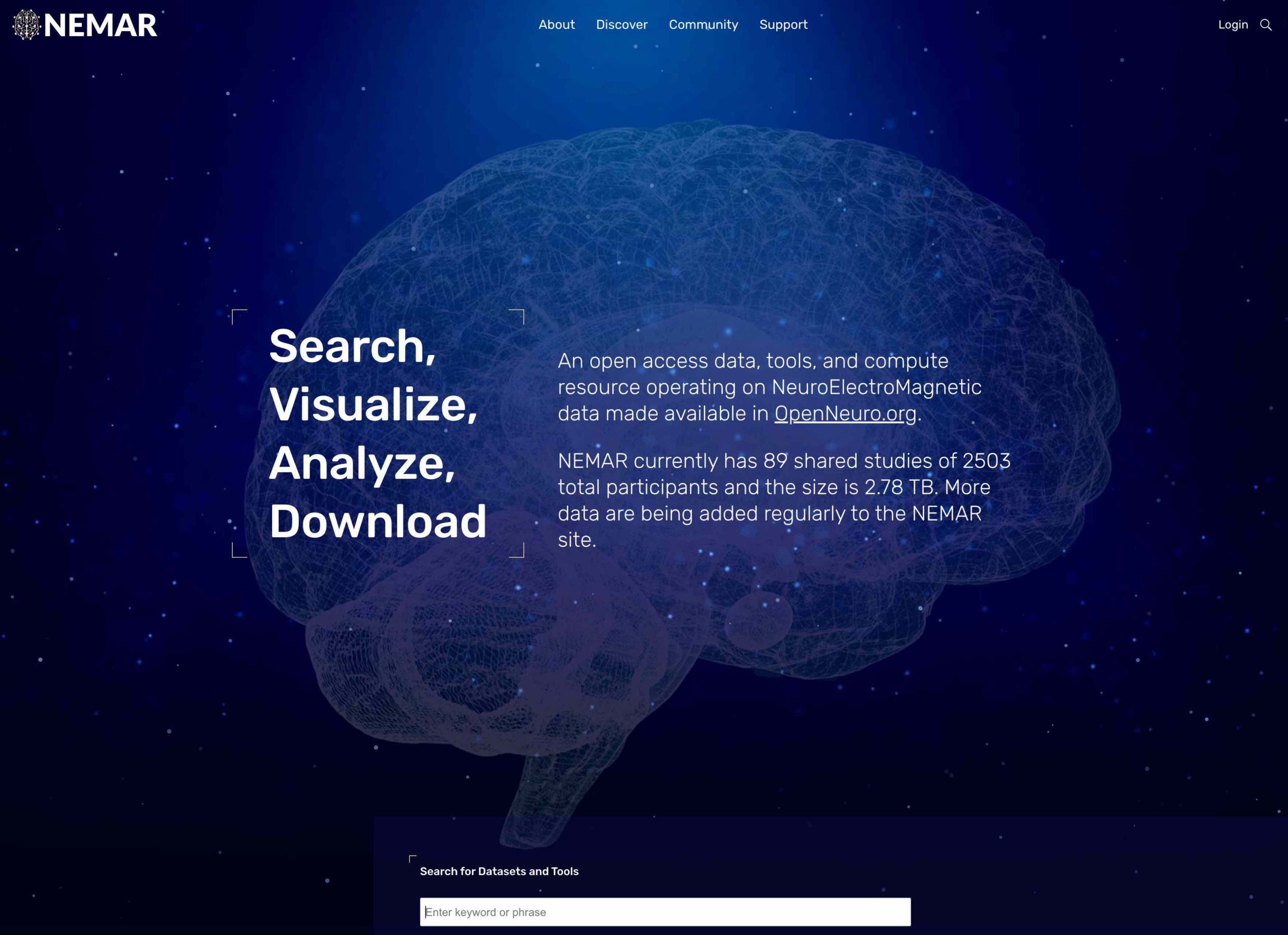NEMAR.org
Type: Software,
Keywords: Human, EEG, MEG, iEEG, ECoG, OpenNeuro, Neuroscience Gateway, Electrophysiology, HED, BIDS
Resource ID: SCR_019100

Integrated data, tools and compute portal for human neuroelectromagnetic data uploaded to OpenNeuro.org
The Neuroelectromagnetic Data Archive and Tools Resource (NEMAR) is a gateway to OpenNeuro for research using publicly available human NEM data (EEG, MEG, iEEG/ECoG). NEM data made available on OpenNeuro can be analyzed in place via the Neuroscience Gateway (NSG, nsgportal.org). We are building web applications to evaluate the quality of uploaded NEM data, to visualize the data, and an easy-to-use pathway to apply user-specified processing to the data via NSG, without requiring data download and re-upload.
* NEMAR is an open, freely available, integrated facility supporting search, visualization, and processing using high-performance computing resources of human neuroelectromagnetic (NEM) brain imaging data (EEG, MEG, iEEG/ECoG).
* NEMAR serves as a portal, offering searching, exploring, and computing on data uploaded and made publicly available on the OpenNeuro archive (openneuro.org).
* NEMAR offers visualizations and quality control measures of the raw data as well as its source-resolved derived data.
* NEMAR supports use of BIDS formats and HED event annotation.
* NEMAR, though close collaboration with the Neuroscience Gateway (nsgportal.org), offers a flexible data processing platform using high-performance computing resources, without need for large data downloads and re-uploads.
* Search for and explore publicly available human EEG, MEG, and ECoG/iEEG data made available by its authors on OpenNeuro using the NERMAR search engine.
* Browse its BIDS files and preprocessed data visualizations.
* Download selected data from OpenNeuro for further processing OR process the data without need for download using the high-performance computing resources made freely available by the Neuroscience Gateway (NSG, nsgportal.org). NSG runs neuroscience software and processing environments including MATLAB, EEGLAB, Freesurfer, Open Brain, Python, R, PyTorch and TensorFlow. Users have near-complete flexibility in designating their processing flows.
In an animal image categorization task, participants were asked to respond quickly by button press whenever they saw an animal in a presented picture. This and another task used a series of 100 images, 50 photographs including an animal mixed with 50 photos with no animal. EEG and behavioral (reaction time) data were collected. Researchers interested in this data may browse its files, download it from OpenNeuro.org, and reprocess it to tackle various neuroscientific questions. Citation: Delorme, A., Richard, G. and Fabre-Thorpe, M., 2010. Key visual features for rapid categorization of animals in natural scenes. Frontiers in psychology, p.21.
MODIFIED STERNBERG WORKING MEMORY STUDY
High-density EEG and behavior (button presses) were recorded in a modified Sternberg working memory paradigm. Trials consisted of a series of presented letters, followed by a memory maintenance delay and then a probe letter, to which the participant had to reply yes or no whether the probe letter had been in the to-be-memorized letter subset. Interested researchers may explore the data at NEMAR.org, then process them directly in their own ways, running on MATLAB, Python, or R via the Neuroscience Gateway, either directly or from the EEGLAB GUI or command line. Citation: Onton, J., Delorme, A. and Makeig, S., 2005. Frontal midline EEG dynamics during working memory. Neuroimage, 27(2), pp.341-356.
A FACE IMAGE PROCESSING AND RECOGNITION STUDY
A multi-modal (MRI+EEG, MRI, fMRI, behavior) neuroimaging dataset on face image perception and recognition memory. This is a refined and repackaged version of the EEG, behavior (button press), and MR head-image data in EEGLAB format from the well-known Henson and Wakeman face categorization dataset. Detailed event annotations using Hierarchical Event Descriptors (HED) give the most complete record of behavior and temporal structure in the experiment. Other versions of these data on OpenNeuro may make available the concurrent MEG and EEG data, a non-concurrent fMRI session, and a subsequent behavioral recognition memory task. Interested users may browse then download the data for further processing on local computer resources, or process it directly running EEGLAB scripts on high-performance computing resources via the Neuroscience Gateway. Original data citation: Wakeman, D.G. and Henson, R.N., 2015. A multi-subject, multi-modal human neuroimaging dataset. Scientific data, 2(1), pp.1-10.
* Human
* An open, integrated, freely available data, tools, and compute resource for human neuroelectromagnetic brain imaging research.
* Data visualizations and quality assessment measure are under development.
* Web browser
Delorme, A., Truong, D., Youn, C., Sivagnanam, S., Yoshimoto, K., Poldrack, R.A., Majumdar, A. and Makeig, S., 2022. NEMAR: An open access data, tools, and compute resource operating on NeuroElectroMagnetic data. arXiv preprint arXiv:2203.02568.
NEMAR.org
OpenNeuro: OpenNeuro.org; Reference: Markiewicz, C.J., Gorgolewski, K.J., Feingold, F., Blair, R., Halchenko, Y.O., Miller, E., Hardcastle, N., Wexler, J., Esteban, O., Goncavles, M. and Jwa, A., 2021. The OpenNeuro resource for sharing of neuroscience data. eLife, 10.
EEGLAB: EEGLAB.org; Reference: Delorme, A. and Makeig, S., 2004. EEGLAB: an open source toolbox for analysis of single-trial EEG dynamics including independent component analysis. Journal of neuroscience methods, 134(1), pp.9-21.
EEGLAB-NSG: Reference: Martínez-Cancino, R., Delorme, A., Truong, D., Artoni, F., Kreutz-Delgado, K., Sivagnanam, S., Yoshimoto, K., Majumdar, A. and Makeig, S., 2021. The open EEGLAB portal interface: High-performance computing with EEGLAB. NeuroImage, 224, p.116778.
Neuroscience Gateway: nsgportal.org. Reference: Sivagnanam, S., Yoshimoto, K., Carnevale, N.T. and Majumdar, A., 2018. The neuroscience gateway: Enabling large scale modeling and data processing in neuroscience. In Proceedings of the Practice and Experience on Advanced Research Computing (pp. 1-7).”
Scott Makeig, Director Swartz Center for Computational Neuroscience
University of California San Diego, La Jolla
TEAM / COLLABORATOR(S)
Arnaud Delorme, Research Scientist, Institute for Neural Computation UCSD
Amitava Majumdar, Associate Director, San Diego Supercomputer Center UCSD
Russ Poldrack, Professor of Psychology, Stanford University
FUNDING SOURCE(S)
* NIH R24MH120037

